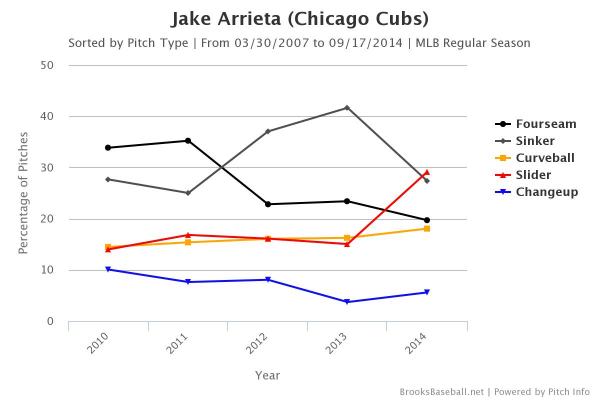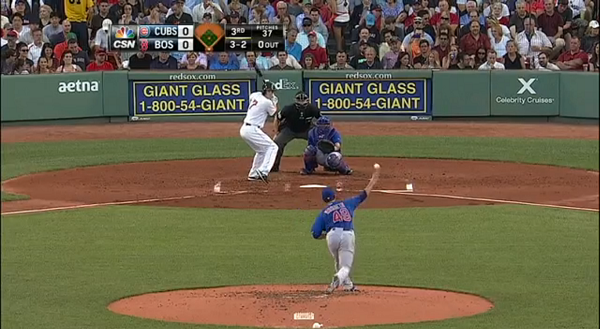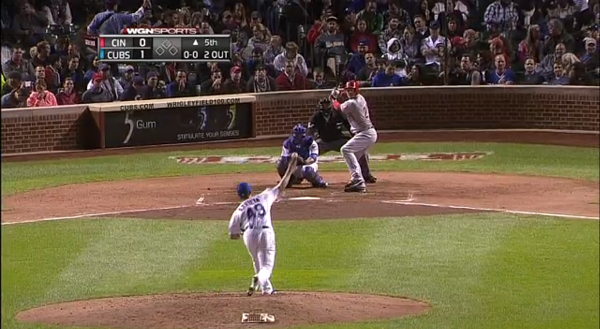Building Jake Arrieta
Let’s go back to 1920. Let’s look at starting pitchers who threw at least 75 innings in consecutive big-league seasons. Relative to last year, Jake Arrieta’s K-BB% has improved by 14 percentage points. That’s the fourth-greatest improvement within the sample. Relative to last year, Arrieta’s FIP- has improved by 64 points. That’s the single greatest improvement within the sample, edging out 2007-2008 Cliff Lee. This is what a breakout looks like. This is what maybe the biggest breakout looks like.
It’s up to you to determine whether or not Jake Arrieta is an ace, but he’s certainly generated ace-like results for the past several months, so if he’s not an ace yet, he’s on the right track. Six times already, he’s held an opponent hitless into the fifth. Three times, he’s held an opponent hitless into the seventh. Twice, he’s held an opponent hitless into the eighth. Arrieta’s flirted with history a few times, and while he hasn’t sealed the deal on an actual no-hitter, he’s at least earned greater familiarity and exposure. The Arrieta breakout, by now, is obvious. And more and more people are becoming aware of it.
So, we think we know what we have. How did this happen? How was Jake Arrieta built? Let’s condense his whole story into a blog post. Seems editorially responsible.
Establish a foundation
Arrieta wasn’t born 6’4, 225, but he got there eventually, probably the former ahead of the latter. Arrieta was blessed with genes allowing for a pitcher’s body, and then he developed interest in becoming a pitcher, which is the other necessary component. Arrieta played with a high-school program in Texas, which is a good place to get better at sports, and then in time he wound up with a major collegiate program, getting him exposure, while also getting him experience and high-level coaching. In college, Arrieta was throwing hard, with other pitches. He met the most general requirements for getting to the majors.
So he got drafted, and he got developed by a big-league organization. More experience, more coaching, more exercise. Staying healthy enough, Arrieta reached the majors and performed inconsistently. Bits and pieces were there, but not often enough, and not often together. But you could say that Arrieta was an unsolved jigsaw puzzle. The puzzle pieces were there on the table — they just had to be properly linked.
Add balance
The secret to better pitching is always the same: improved mechanical consistency. You can repeat your performance if you can repeat your delivery. With a consistent delivery, a pitcher can locate his fastballs, and then he can build off that to make the other pitches work. What about a pitcher who learns a new pitch, you say? A pitch is just a grip and an arm movement. It’s nothing without mechanical consistency. Everything has the same basic explanation.
With Chris Bosio and the Cubs, Arrieta’s worked on his throwing motion. He’s forever been working on his throwing motion — that never really stops — but with the Cubs, instruction has clicked. Click through to that link, and you can hear Arrieta for yourself, talking about keeping his shoulders level, and talking about timing with his front leg. Arrieta’s just tried to find repeatable balance, and from all indications, he’s had it. He’s put together a throwing motion that keeps him comfortable and powerful, and better consistency means better command, and better command means better everything. Used to be, Arrieta could locate his pitches, sometimes. Now he can locate his pitches more of the times.
Add a different mix
Some people say that Jake Arrieta has a cutter. Arrieta himself says he has a hard slider. It doesn’t really matter — those are just different words for the same thing, and, armed with his greater consistency, Arrieta’s grown a hell of a lot more comfortable with his slider in 2014. Eno wrote about this all the way back in June. With the help of Brooks Baseball, let’s watch Arrieta’s mix over time:
He’s doubled up on his slider usage. It’s cut into his sinker and fastball usage. He loves the damned thing. He’ll throw it on the first pitch. He’ll throw it behind in the count. He’ll throw it ahead in the count. He’ll throw it with two strikes. He’ll throw it to lefties. He’ll throw it to righties. He’ll throw it low. He’ll throw it at the hands. Arrieta has a pitch at 94 that tails arm-side, he has a pitch at 94 that doesn’t tail arm-side as much, and he has a pitch at 90 that breaks down and glove-side. The first one and the last one are his primary pitches now, and they behave in opposite ways with little velocity difference. That’s not very nice.
Add a different release
Going back to the Brooks Baseball well, let’s look at Arrieta’s horizontal release points over time:
Arrieta’s throwing the ball more from the third-base side than ever, and while it might seem like a minor thing, hitters have noticed. Said David Ross:
“He’s definitely a different pitcher,” Ross said. “He may have moved sides of the rubber. I’d have to check the video to see that. I just remember seeing his ball a lot better [previously] than I did today. It was definitely across [the zone]. It felt almost like he was throwing behind me and locating down and away. That’s really tough to do. You ask any pitcher, it’s probably one of the hardest things to do.
“[Arrieta is] really tough on right handers. He’s right on the third-base side of the rubber. It seems like the ball starts behind you,” Zimmerman said.
A few years ago, Arrieta moved to the other side of the rubber. So he’s toyed with this before, but never with his current level of consistency. Now he’s the best equipped to make a worthwhile tweak work, and if you look at some screenshots, it seems like this is about more than just throwing from a few inches over.
Baltimore, 2013:
Chicago, 2014:
Chicago, 2014:
Pay attention to his left foot and left leg. In the Baltimore image, Arrieta’s stepped forward, toward the plate. In the Chicago images, Arrieta’s stepped more toward the right-handed batter’s box, and his leg as we can see it is at a more pronounced angle. This could contribute to that feeling of Arrieta throwing from behind a righty, because it looks like he’s stepping toward a right-handed batter until he lets go of the ball. I’ve never stepped in against Arrieta before, but this could add to his deception, and given how hard he throws, every split-second matters. His somewhat unconventional delivery could make the ball more tricky to pick up.
So you put everything together. To put it one way, a year ago, Arrieta threw 29% of his pitches with two strikes. This year, he’s thrown 29% of his pitches with two strikes. But, a year ago, he got strikeouts with 17% of those pitches. This year, he’s at 23%.
But let’s look at some pitch locations. Here’s some evidence of better consistency:
| Curve spot | 2013 | 2014 |
|---|---|---|
| RHB, below zone | 37% | 58% |
| LHB, below zone | 47% | 60% |
Arrieta wants to use that curveball as a wipeout pitch. This year, he’s been a lot better about keeping the pitch down, below the zone. The worst thing that happens with a low curveball is that it bounces in the dirt. Worse things happen to curveballs in the zone. Depending on the timing, those things can be much worse.
How about spotting that slider?
| Slider spot | 2013 | 2014 |
|---|---|---|
| RHB, over plate | 51% | 69% |
| LHB, over plate | 52% | 70% |
Arrieta used to push a lot of his sliders glove-side, away against righties and in against lefties. By changing his release, and by improving his consistency, Arrieta’s brought the slider more over the plate. By being able to throw the pitch for strikes, Arrieta can throw it in any count, against any hitter, and the hitter has to prepare for a few different pitches at 90+ miles per hour. Arrieta calls the pitch a hard slider, but his would be an unusual slider that he likes to throw in the strike zone. An Arrieta slider over the plate isn’t a hanging mistake. It’s usually intentional.
To close, let’s look at Arrieta’s more ordinary fastballs:
| Fastball spot | 2013 | 2014 |
|---|---|---|
| RHB, inside | 21% | 42% |
| LHB, outside | 48% | 70% |
This is another function of throwing more from the third-base side. That opens up a different part of the plate, and this year Arrieta has doubled his rate of inside fastballs against righties. Meanwhile, his rate of outside fastballs against lefties is also up more than 20 percentage points, as Arrieta can get his pitches to that arm-side edge. What this allows him to do is throw different hard pitches to different halves of the zone, keeping barrels away, and then by mixing in the sharp curveball, he can also just keep bats away. Arrieta’s curveball has a career-best whiff rate. His fastballs have career-best slugging percentages. A year ago, 16% of Arrieta’s two-strike curves got strikeouts. This year that’s nearly doubled. You can ask a hitter to prepare for only so much.
Jake Arrieta sure looks like an ace these days, a summer after getting traded for a No. 3 in his walk year. What’s been the secret behind Arrieta’s emergence? Actually, there have been a number of things, and without any one of them, who’s to say where we’d be today? Is it because of the mechanical work? Is it because of the slider? Is it because of the release? The answer, simply, is “yes”, as Arrieta’s benefited from everything in raising his game to an incredible level. If you’re looking for a shortcut, though, you can never go wrong with “improved mechanical consistency.” Arrieta’s motion now is more consistent. Therefore, so are his results, at a level inconsistent with his history.
Jeff made Lookout Landing a thing, but he does not still write there about the Mariners. He does write here, sometimes about the Mariners, but usually not.





OUTSTANDING article